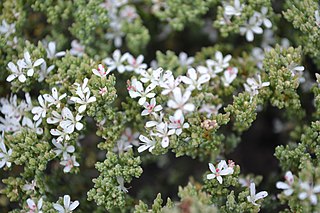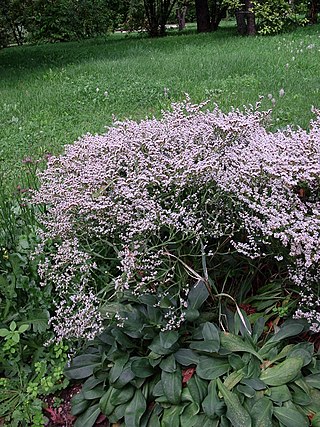
Capparales is a botanical name of an order of flowering plants. It was used in the Cronquist system for an order in subclass Dilleniidae and in the Kubitzki system, nowadays. In the 1981 version of this system it included :

Genista is a genus of flowering plants in the legume family Fabaceae, native to open habitats such as moorland and pasture in Europe and western Asia. They include species commonly called broom, though the term may also refer to other genera, including Cytisus and Chamaecytisus. Brooms in other genera are sometimes considered synonymous with Genista: Echinospartum, Retama, Spartium, Stauracanthus, and Ulex.

Linaria is a genus of almost 200 species of flowering plants, one of several related groups commonly called toadflax. They are annuals and herbaceous perennials, and the largest genus in the Antirrhineae tribe of the plantain family Plantaginaceae.

Helianthemum, known as rock rose, sunrose, rushrose, or frostweed, is a genus of about 110 species of flowering plants in the family Cistaceae. They are widely distributed throughout the Northern Hemisphere, especially in the Mediterranean.

Erodium is a genus of flowering plants in the botanical family Geraniaceae. The genus includes about 120 species with a subcosmopolitan distribution, native to Europe, North Africa, Asia, Australia, and more locally in North and South America. They are perennials, annuals, or subshrubs, with five-petalled flowers in shades of white, pink, and purple, that strongly resemble the better-known Geranium (crane's-bills). In English-speaking areas of Europe, the species are known as stork's-bills. In North America they are known as filarees or heron's bill.

Biscutella is a genus of over 50 species of flowering plants in the family Brassicaceae.

Pulicaria is a genus of flowering plant in the sunflower family, native to Europe, Asia, and Africa. In North America Pulicaria is known by the common name false fleabane.

Lachnocapsa spathulata is a species of flowering plant in the family Brassicaceae, and the only species in the genus Lachnocaspa. It is found only on Socotra, Yemen. Its natural habitats are subtropical or tropical dry shrubland and rocky areas.

Chaenorhinum is a genus of flowering plants. It includes 27 species of annual and perennial herbs native to the Mediterranean Basin, Europe, and western Asia to the western Himalayas. They thrive in dry stony areas and scree. They are closely related to snapdragons. The leaves are linear to oblong or rounded, opposite at the base. The flowers resemble snapdragons, being typically zygomorphic, hooded, lobed and spurred. They are borne in terminal racemes or singly in the leaf axils of the branching stems.

Haloxylon is a genus of shrubs or small trees, belonging to the plant family Amaranthaceae. Haloxylon and its species are known by the common name saxaul. "Saksaul" is a common Turkic word that entered Russian through Kazakh.

Frankenia is the only genus in the Frankeniaceae family of flowering plants. Other genera have been recognized within the family, such as Anthobryum, Hypericopsis and Niederleinia, but molecular phylogenetic studies have consistently shown that they all belong inside Frankenia. Frankenia comprises about 70–80 species of shrubs, subshrubs and herbaceous plants, adapted to saline and dry environments throughout temperate and subtropical regions. A few species are in cultivation as ornamental plants.
Klaus Kubitzki was a German botanist. He was Emeritus professor in the University of Hamburg, at the Herbarium Hamburgense. He is known for his work on the systematics and biogeography of the angiosperms, particularly those of the Neotropics, and also the floristic record of the Tertiary era. His plant systematic work is referred to as the Kubitzki system. He was a member of the American Society of Plant Taxonomists.

Plagianthus is a genus of flowering plants confined to New Zealand and the Chatham Islands. The familial placement of the genus was controversial for many years, but modern genetic studies show it definitely belongs in the Malvaceae subfamily Malvoideae. The name means "slanted flowers".

Goniolimon, sometimes called the statices, are a genus of flowering plants in the leadwort and plumbago family Plumbaginaceae, native to northern Africa, southern Europe, western and central Asia, Siberia, Mongolia and China. Low-lying perennial shrubs, some species are cultivated as ground covers.
Krapovickasia is a genus of flowering plants in the mallow family Malvaceae, disjunctly distributed in Mexico, Brazil, Paraguay, Uruguay and Argentina. Perennial herbs, they have yellowish to peach or faded rose colored flowers.
Bastardiastrum is a genus of flowering plants in the mallow family Malvaceae and is native to Mexico. They are shrubs or subshrubs with viscid stems.
Telephium are a genus of flowering plants in the family Molluginaceae or Caryophyllaceae, found in Mediterranean parts of Europe, Africa, the Arabian Peninsula, and western Asia. They are annual or perennial herbs, sometimes becoming woody at their bases. Together with Corrigiola they form the tribe Corrigioleae.

Corynabutilon is a genus of flowering plants in the family Malvaceae, native to southern Chile and Argentina. They are shrubs or small trees.
Fumana laevipes is a species of shrub in the family Cistaceae. They have a self-supporting growth form and simple, broad leaves and dry fruit. Individuals can grow to 10 cm tall.














